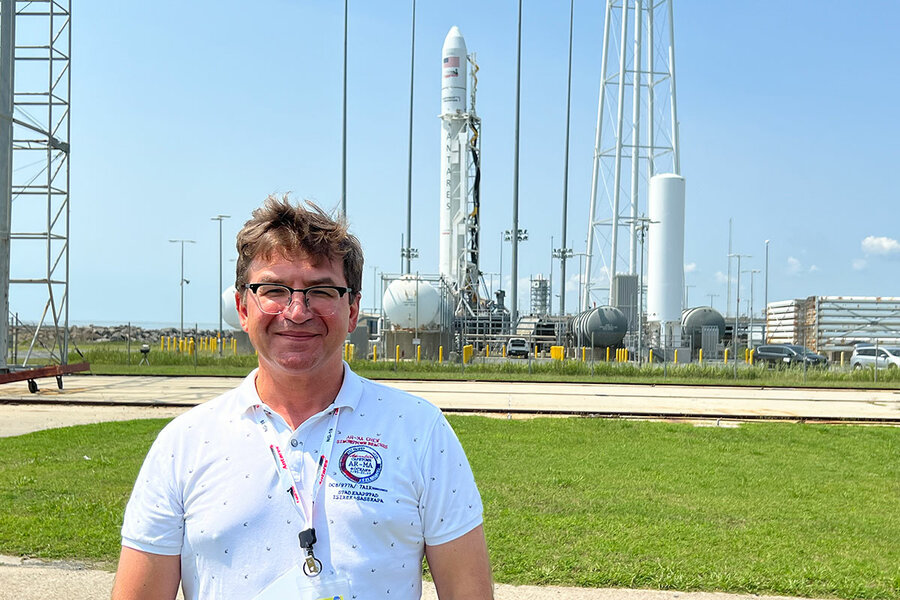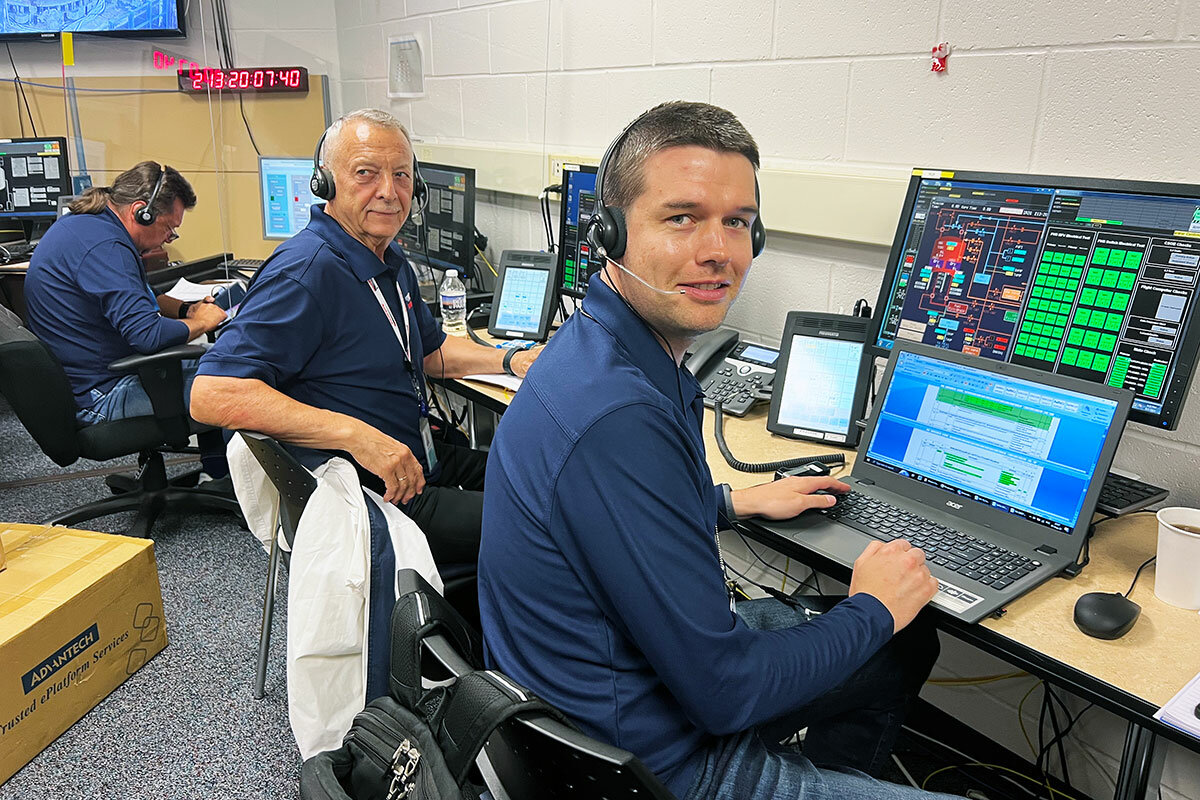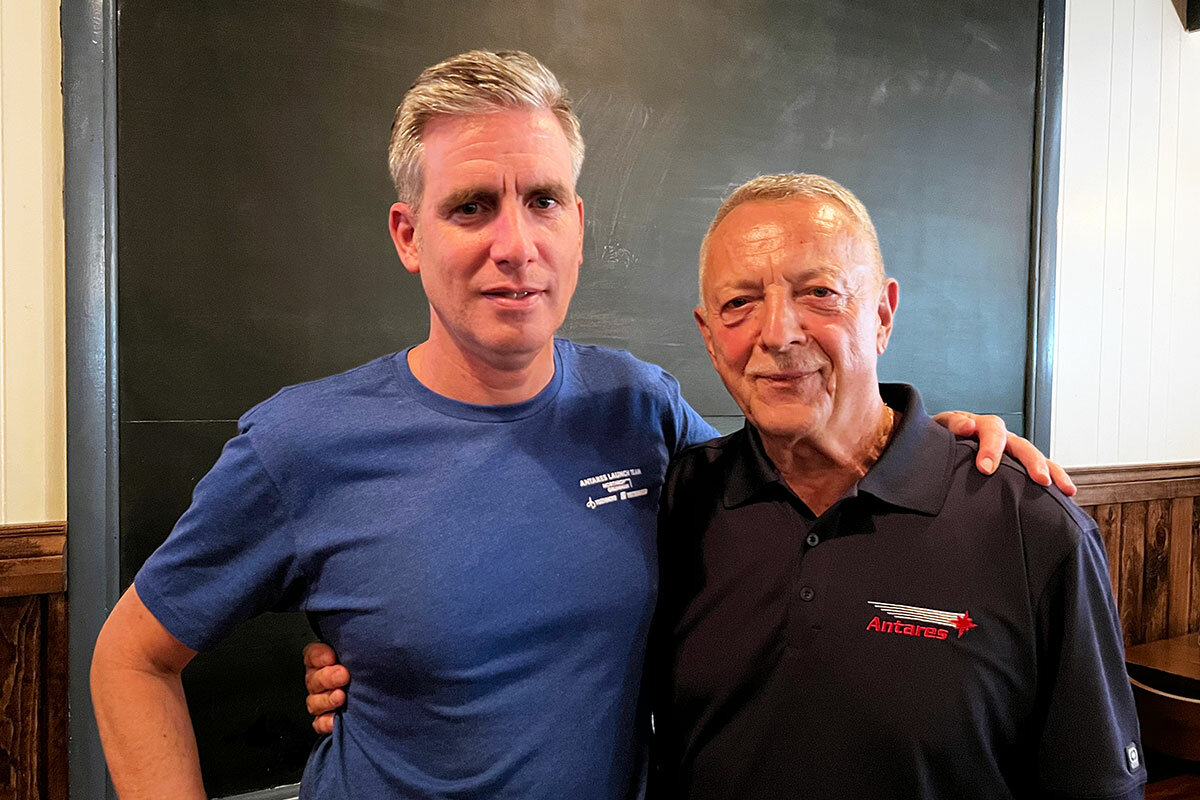US-Ukraine space project taught resilience, innovation. Why it’s over.
Loading...
| Wallops Island, Va.
Amidst the whoops and applause that cheered the Antares rocket as it rose from NASA’s Virginia seaboard launch facility one evening last week were the hugs and thumbs-ups exchanged by Ukrainian aerospace engineers and officials with their American counterparts.
The faultless launch of a payload destined for the International Space Station marked more than a decade of U.S.-Ukrainian cooperation on the Antares program, with Ukraine providing the first stage of the workhorse rocket.
“This launch was so perfect; it makes all of us from Ukraine so proud of our years of work with our American friends,” says Dmytro Nikon, chief economist with the Ukrainian aerospace manufacturer Yuzhmash.
Why We Wrote This
A story focused onA little-known but fruitful partnership in space between the United States and Ukraine has come to an end, a victim of the war with Russia. But the Antares program has left warm memories on both sides.
Yet the triumph of the launch, the 18th with a Ukrainian first-stage core, was overshadowed by the reality that it was also the end of the road for Ukraine’s participation in the Antares program.
“Certainly there is regret and sadness that this biggest of international projects for us is coming to a close,” says Anatolii Agarkov, a chief adviser to the director general of Yuzhnoye, Ukraine’s state-owned designer of satellites and rockets. “Working so long with the U.S. expanded our international horizons,” he goes on, “but sadly the war has scuttled all that.”
Why the flagship of U.S.-Ukraine space cooperation would be ending even as many other facets of the two countries’ relationship are expanding has one obvious explanation: Russia’s war in Ukraine.
Ukraine’s first stage for the Antares rocket is powered by Russian engines. A Russia at war with Ukraine is refusing to provide those first-stage rockets any longer, and when the Ukrainians were unable to come up with replacement engines, Northrop Grumman – the New York-based aerospace company that makes Antares rockets – canceled its contract for two more first stages.
No Russian engines, no Ukrainian first stage, at least for the time being.
But a number of broader forces have also undermined the joint project, ranging from the commercial space industry’s shift to lucrative military applications, to a global trend away from international space cooperation to more nationalist programs and the militarization of space.
The shift is evident in the Antares program.
Northrop Grumman, a commercial resupplier for the International Space Station, wants to grow military contracts as a share of its business. But the Pentagon restricts most of its contracts to domestic suppliers.
Thus Northrop Grumman is now working with Austin-based Firefly Aerospace to provide it with new space components, including a first stage for Antares.
The irony of that partnership is that Firefly was built by a Ukrainian billionaire, Max Polyakov, who had hoped to develop a world-class commercial space company drawing on U.S. and Ukrainian strengths. But Mr. Polyakov saw his dream shattered last year when he was forced to sell his interest in the company because of U.S. government concerns that his ownership posed national security and technology-transfer risks.
Working with Firefly, Northrop Grumman has now set an all-American Antares launch for 2025.
Still, despite a trace of sadness underlying the joy of a successful launch, everyone involved in the project agrees on one thing: Ukraine’s cooperation with the U.S. on the Antares rocket has benefited both sides.
Ukraine’s state-owned aerospace companies have learned the ropes of the competitive commercial space industry, people here say, and the U.S. has had access to Ukraine’s top-quality (though somewhat outdated) space technology, a scion of the Soviet space program.
“All along the way, the Americans have shown respect to our knowledge and practical experience,” says Mr. Agarkov. Noting that the learning has “gone both ways,” he adds with a smile that “the system we come from had very strict rules and did not encourage innovative thinking. From our American friends, we learned to be much more open to innovation.”
For the Ukrainian staff on-site in Virginia, the launch was a bittersweet moment.
“On one hand, of course, we all feel disappointed that this experience and time-tested project had to stop,” says Oleksandr Iatsun, chief of the telemetry team and measurement systems for Yuzhnoye. “But on the other hand, it’s been a very positive and enriching experience,” he adds, “so I’m cautiously hopeful for the future. We’ve made the progress to march on.”
An engineer who has been part of Ukraine’s involvement with the Antares program since the collaboration began in 2009, Mr. Iatsun highlighted the benefits he, his company, and Ukraine have reaped from the cooperation with the U.S.
Antares “wasn’t the first example of international space cooperation for Ukraine,” he says, but “here there has been a level of integration and interfacing of systems that was a new challenge for us ... one we’ve learned from.”
One “big plus” he sees from the decade of Ukraine’s involvement with Antares launches is that a new generation of Ukrainian aerospace engineers has developed expertise with a Western orientation, less influenced by the Soviet roots of Ukraine’s space program.
“My early experience in my career was with Russia,” he notes, “but the younger guys have learned and now follow Western protocols. I think that will serve us well in the future.”
The Americans who have worked on Antares spoke in equally glowing terms of their experience with the Ukrainians and said that they learned just as much from them.
“The Ukrainians taught me to methodically work through everything,” says Patrick Hoar, who oversaw the Ukrainians’ retooling of their highly successful Zenit rocket to provide the Antares first stage. “I learned there’s an efficiency in doing everything right, right away.”
Perhaps most impressive, several Americans said, was how the Ukrainians carried on despite Russia’s war on their country. “Their resilience is astounding,” says Joshua Valentine, Northrop Grumman’s electrical lead at Wallops. “We all could learn from their ability to focus on our mission’s success in the face of what’s happening in their homeland.”
Both teams cite Russia’s war as the direct cause of the end of Ukraine’s participation in the Antares program. There is a shared frustration that Russian President Vladimir Putin appears to be achieving one of his goals: weakening, if not destroying, Ukraine’s economic vitality.
But other forces, too, have worked against the collaboration.
“Over the last decade, we’ve seen a resurgence of nationalism,” says Mr. Valentine, as countries turned away from international cooperation, “prioritizing their security fears. ... We see the impact of that in space programs around the world.”
Indeed this militarization of space programs is evident to some degree in Ukraine.
The Ukrainians at Wallops acknowledged that the war has prompted a certain redirection of the country’s aerospace industry, but beyond acknowledging their army’s effective use of satellites, they were reluctant to give any details.
But mostly, the Ukrainians are adamant that the world should see their country in a new light.
“Of course, the war has been terrible, but that is not all Ukraine is,” says Mr. Iatsun, who has been in Virginia since September of last year. “In a small way, because of this program, the world is learning that Ukraine is not just the war or a source of grain,” he adds, “but a country with a top space program that will have an international presence for many years to come.”
That faith in the future pervades the Ukrainian Antares team.
“That this is the last launch for us, I accept it – all good things must come to an end, as they say,” says Vadym Demchenko, deputy program manager of Yuzhnoye’s Antares program.
“And usually,” he adds with a smile, “the end of something also means the opening of a new chapter. I think we’re all hopeful and excited about that.”









